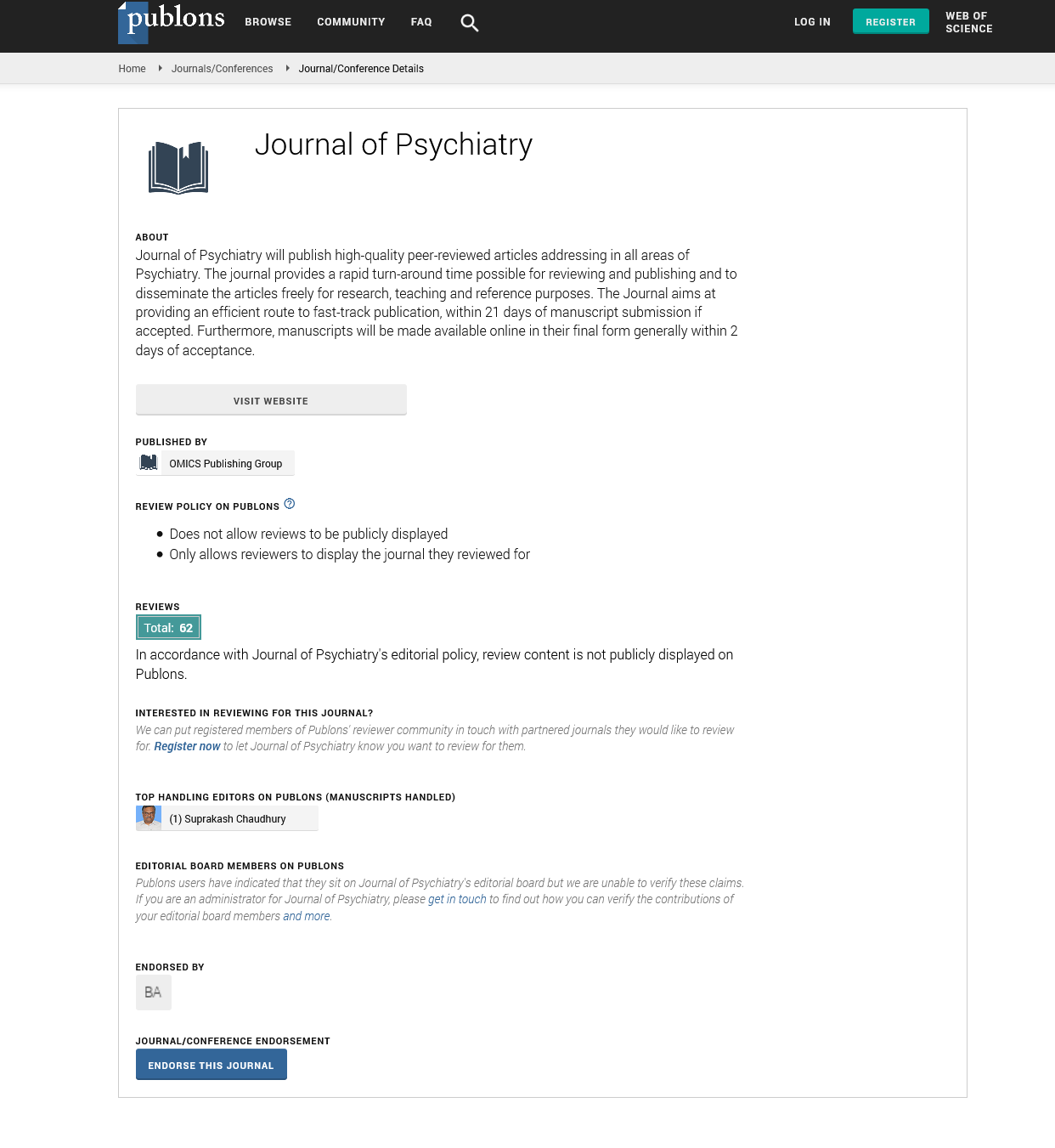PMC/PubMed Indexed Articles
Indexed In
- RefSeek
- Hamdard University
- EBSCO A-Z
- OCLC- WorldCat
- SWB online catalog
- Publons
- International committee of medical journals editors (ICMJE)
- Geneva Foundation for Medical Education and Research
Useful Links
Share This Page
Open Access Journals
- Agri and Aquaculture
- Biochemistry
- Bioinformatics & Systems Biology
- Business & Management
- Chemistry
- Clinical Sciences
- Engineering
- Food & Nutrition
- General Science
- Genetics & Molecular Biology
- Immunology & Microbiology
- Medical Sciences
- Neuroscience & Psychology
- Nursing & Health Care
- Pharmaceutical Sciences
Commentary - (2022) Volume 25, Issue 2
Personality Traits among Psychiatric Out-Patients with Suicide Attempt
Melesse Belayneh*Received: 02-Feb-2022, Manuscript No. JOP-22-15929; Editor assigned: 04-Feb-2022, Pre QC No. JOP-22-15929(PQ); Reviewed: 18-Feb-2022, QC No. JOP-22-15929; Revised: 25-Feb-2022, Manuscript No. JOP-22-15929(R); Published: 02-Mar-2022, DOI: 10.35248/2378-5756.22.25.492
About the Study
"Suicide" comes from the Latin word for "self-murder" It is a deadly act that expresses the person's death wish. Suicidal ideation and attempted suicide strongly predict suicide-related deaths. It can lead to negative consequences such as injury, hospitalization and loss of liberty. Psychotic patients with attempted suicide have greater suicidal ideation than patients with attempted suicide. Clinical and social studies suggest a link between suicide attempts and psychological characteristics such as aggression, anger, and impulsivity. Aggression is associated with suicidal tendencies in mental disorders. Suicide attempts were more likely to be lifetime aggression than non-suicide-prone patients, and the characteristics of suicide attempts and lifetime aggression in mental disorder patients were correlated. There is strong evidence of a relationship between personality traits and suicide.
Suicide attempt is a self-harm with non-fatal consequences. Studies have shown that increased hospitalization for selfinflicted harm (SIH) is likely to be associated with psychosocial factors in SIH cases. We conducted a study to investigate the character characteristics, socio-demographic profiles, and mental disorders of suicide attempts at a tertiary care hospital.
A study of medical records of psychiatric patients with or without suicide attempt shows that individuals with suicide attempt had anger, aggression, anxiety, and depression personality profiles. Depressed patients with borderline personality traits were characteristically vulnerable compared to other groups and had familial generalized anxiety disorder. Borderline personality pathology and narcissistic personality pathology are linked as unique contributors to the consequences of suicidal ideation. Impulsivity and aggression have been shown to be important risk factors for suicide and are usually found in patients with behavioral disorders, personality disorders, substance use disorders, and bipolar disorder.
The majority of subjects are female, married, educated, and the most common age group is 20-29 years, 20 years. Most of them were Hindus with low socio-economic status, lived in families and cities, and were housewives. Poisoning was the most common mode of suicide attempt, and organ phosphorus compounds were the most commonly used poison. Some (13.3%) had a history of attempted suicide, and 5.3% had a family history of attempted suicide. Most cases 63 (55.8%) were referred by internal medicine, followed by emergency 28 (24.8%), self-care 18 (15.9%), and pediatric 4 (3.5%). The most common psychiatric ICD10 diagnoses were substance use disorders, primarily alcohol (42%), indications (34%), and mental disorders (22%). Emotional instability was the most common personality trait 70 (61.9%), followed by depressive tendencies 46 (40.7%).
Emotional instability was present in up to 70 (61.9%) of patients, followed by depression propensity 46 (40.7%). Introversion is 42 (37.2%), activity 37 (32.7%), social desirability 23 (20.4%), predominance 21 (18.6%), cyclothymia 20 (17.7%), delusional tendency 14 (12.4%)), the super-ego was 10 (12.4%). 8.8%). Clinical and social studies suggest a link between suicide attempts and psychological characteristics such as aggression, anger, and impulsivity. Identifying personality disorder as a risk factor for suicide attempt is an important consideration for both research and clinical care. Personality disorders occur in 34% of all cases, with mentally unstable and anxious personality disorders being the most common.
Citation: Belayneh M (2022) Personality Traits among Psychiatric Out-Patients with Suicide Attempt. J Psychiatry. 25:492.
Copyright: © 2022 Belayneh M. This is an open-access article distributed under the terms of the Creative Commons Attribution License, which permits unrestricted use, distribution, and reproduction in any medium, provided the original author and source are credited.

